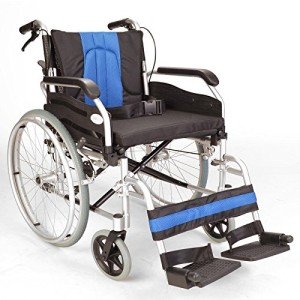Bariatric Wheelchair Seat Width
Seat Width
Having the right seat width is necessary to wheelchair users who spend longer periods in their chairs. Too narrow a seat will cause pressure on the hips and thighs which might lead to sores or pressure points. Having too wide a seat can also make it difficult for the user to reach the hand rims to propel themselves or maneuver in little areas.
To measure the right seat width an individual would rest on a chair generally and have their measurement taken across their lap at the best point which is usually their hips. A wheelchair measuring tape can be utilized to measure this, but a backyard stick is preferred as it avoids individuals from wrapping the tape around their hips which would give an incorrect result.
The basic wheelchair seat width is 16" (narrow grownup), 18" (standard grownup), and 20" (wide adult). For bariatric electric wheelchairs for sale , a 24" seat is offered. This heavy-duty additional wide bariatric wheelchair from Medline features swing-away footrests, a carbon steel frame with rust- and chip-resistant chrome plating, and easy-to-clean vinyl upholstery. It has a weight capacity of 500 pounds.

Seat Depth
Traditionally, the seat depth of a bariatric wheelchair was included 2" to the measurement taken at the user's best point (normally their hips). This was indicated to accommodate additional layers of clothes that may be used throughout winter. However, this practice is ending up being less common as wheelchair users have the ability to spend more time inside and are not using long coats. This makes the seat depth of a chair lesser when selecting a bariatric wheelchair. However, it is still crucial to select an alternative that uses adequate assistance for bigger users.
The Medline folding extra wide bariatric manual wheelchair includes a comfy 24" seat width and a heavy-duty slide tube silver vein frame. It likewise has an adjustable axle and tool-free elevating legrests.
Seat Height
When it concerns identifying the correct wheelchair seat width you should always measure from the user's best point which is normally their hips. You will likewise require to think about whether the user is going to be wearing a winter coat as this might add 2" to the width required.
When a wheelchair is in use it must just be operated on level surfaces with the wheel locks completely engaged. This is to prevent the chair from having the ability to move slopes that are 10 degrees or higher. It is also important to keep in mind that any activity that might shift the center of gravity in the chair ought to be done with care. This includes grabbing items that require the individual to lean out of their seat or trying to stand from it.
Whenever you have the chair in usage it is recommended that you regularly check it for damage and lubricate any locations that are deemed needed. For instance, the casters need to be oiled by removing the caster fork and utilizing a multi-purpose grease to apply to the caster stem bearings. Also, the foot plates can be adjusted by loosening the bolt and after that moving them to the wanted position. This allows the feet to sit easily on the footplate and avoids any pressure points from forming. This can be extremely unpleasant for the user and if left ignored, can lead to press sores.
Weight Capacity
Bariatric wheelchairs are developed to support more weight than standard wheelchairs. This makes them sturdier and better geared up to handle falls. They are also generally larger and wider, making them less maneuverable in tight spaces than standard wheelchairs. They require vehicles with unique ramps and lifts to fill them, along with motorists who understand how to best transport them from one location to the next.
When choosing a wheelchair, consider its weight capacity as it will be the primary determining consider whether it will accommodate your passenger's needs. The weight capacity of the chair is frequently noted as a fixed load, suggesting that it suggests the quantity of weight the chair can easily hold while stalling. However, some makers also list an active load that is based on a drop test and can replicate the impact of someone sitting down in the chair. This may be a more trusted measurement of the weight limit, depending upon your needs.
If you prepare to carry out activities that move your center of gravity in the seat (such as reaching for things), make certain to have front casters pointed in a forward instructions and wheel locks engaged so the chair will not topple. Also, check that casters are oiled frequently to prevent excessive wear and abrasions. The lubrication treatment includes getting rid of the fork, separating the caster from the wheel, and greasing the caster stem bearings with top quality multi-purpose grease.
